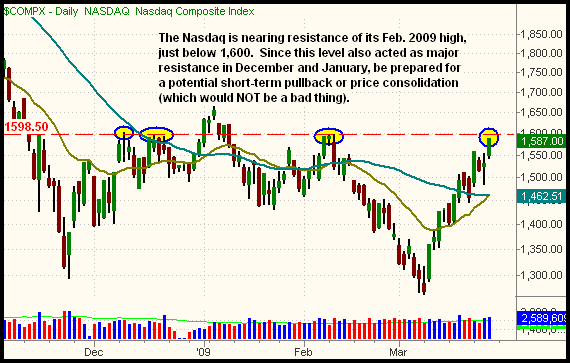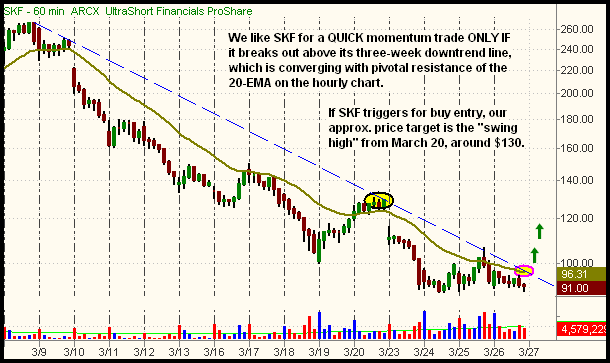Since financials showed relative weakness by failing to participate in yesterday's rally, the sector could be one of the first to fall if the broad market shows any weakness, or even mere consolidation, over the next week.
Stocks built on momentum from the previous afternoon's closing rally, enabling the main stock market indexes to snag another round of strong gains and close at their highest levels of the past six weeks. After opening firmly in positive territory, the major indices drifted sideways to higher throughout the session, eventually finishing at their best levels of day. The Nasdaq Composite jumped 3.8%, as both the S&P 500 and Dow Jones Industrial Average climbed 2.3%. The small-cap Russell 2000 and S&P Midcap 400 indices advanced 4.4% and 3.9% respectively.
Volume edged higher across the board, enabling the major indices to register a bullish "accumulation day." Total volume in the NYSE rose 2% above the previous day's level, while volume in the Nasdaq increased 5%. Obviously, market internals were positive in both exchanges, but there was clear bullish divergence in the Nasdaq, where advancing volume outnumbered declining volume by more than 16 to 1. The NYSE adv/dec volume ratio was positive by less than 3 to 1.
When a stock market rally is primarily led by extremely weak sectors bouncing off their lows, rather than leading sectors breaking out to new highs, the rally is usually short-lived. As such, it's important to point out one key difference between yesterday's rally and most other "up" days this month; yesterday's gains were not driven by dead sectors, such as banking and insurance, that are merely bouncing off their lows. Rather, a broad range of industry indexes such as Semiconductors, Software, Retail, and Transportation all logged percentage gains greater than the main stock market indexes. The Bank Index ($BKX), on the other hand, gained just 0.5% yesterday. Overall, we view this as a possible sign that investors may slowly be becoming more comfortable with market risk by deploying funds outside of perceived "value" plays. Such a change of sentiment is necessary in order for the stock market's rally to be sustainable. Nevertheless, the Nasdaq Composite is now approaching a major level of price resistance that could trigger a pullback or short-term price consolidation. This is shown on the daily chart below: 
The dashed horizontal line on the chart above marks resistance of the Nasdaq's prior significant high from last month, which also acted as resistance throughout December and January. Because the Nasdaq has shown relative strength over the past several weeks, it is the only one of the major indices that has already reached resistance of its February highs. Since the Nasdaq has shown leadership on the way up, a pullback triggered by bumping into its February highs could similarly cause the S&P and Dow to retrace a greater percentage of their recent gains than the Nasdaq.
Though the broad market remains in both short and intermediate-term uptrends, resistance of the Nasdaq's February highs means it may be a good idea to consider just one or two short positions (or inverse ETFs) near current levels, especially if you're now heavily positioned on the long side of the market. Trailing tight stops on winning long positions isn't a bad idea either. One bearish setup we're monitoring for potential entry is the inversely correlated UltraShort Financials ProShares (SKF). The hourly chart appears below: 
As explained on the chart above, we're planning to buy SKF if, and only if, it breaks out above resistance of its multi-week downtrend line, which neatly converges with resistance of the 20-period exponential moving average on the hourly chart (regular subscribers should note our specific trigger, stop, and target prices below). Ideally, such a breakout would occur as the Nasdaq retraces at resistance of its February high, causing the S&P and Dow to lead the way lower to the downside. Since financials showed relative weakness by failing to participate in yesterday's rally, the sector could be one of the first to fall if the broad market shows any weakness, or even mere consolidation, over the next week.
If you plan to trade this setup, there are a few things to be aware of. First is the importance of not "jumping the gun" with a premature entry before SKF breaks out. Since SKF is consolidating at its lows, there's nothing to prevent it from making another leg lower right now. However, if SKF breaks out above its downtrend line, short-term momentum should reverse. The second point is to remember the UltraShort sector ETFs are only effective for very quick, momentum-based trading, which is all we're planning to do with the SKF (read more about this in our Feb. 6 commentary). Finally, be aware that SKF is an extremely volatile ETF. As such, be sure to decrease share size accordingly, in order to account for the wider than usual stop that is necessary when trading SKF.
Open ETF positions:
Long - HHH, USO, UGA, SLV, UDN
Short - (none)
Deron Wagner is the Founder and Head Trader of both Morpheus Capital LP, a U.S. hedge fund, and Morpheus Trading Group, a trader education firm launched in 2001 that provides daily technical analysis of the leading ETFs and stocks. For a free trial to the full version of The Wagner Daily or to learn about Wagner's other services, visit MorpheusTrading.com or send an e-mail to deron@morpheustrading.com.